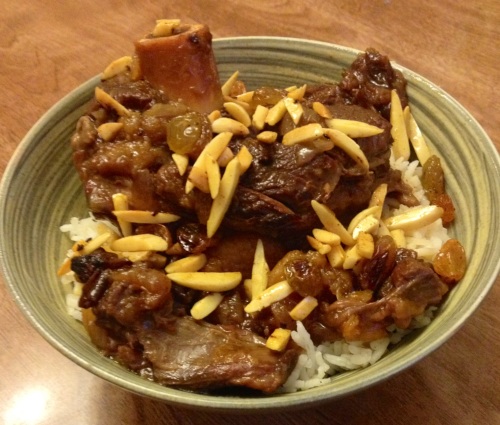I have been lucky enough to travel extensively throughout the Middle East and Europe, and many of my favorite memories involve getting to know other women while helping out in their kitchens. In Arab culture, if you are a guest and you offer to help, you are promptly rebuffed and told to relax. With a little perseverance, however, I learned that women in every country I have visited are extremely proud of the food that they make for their friends and families. Once I showed genuine interest in how they were preparing their food, I found my hosts were more than happy to teach me their recipes, techniques, and cultural cooking practices inscribed in them by their mothers, aunts and grandmothers.
When testing a recipe for galbi-tang, a Korean beef short rib soup, I asked Diane why the ribs were parboiled and not seared or broiled during their preparation. She stated that parboiling the ribs was a traditional step in Korean cooking in order to remove fat and blood from the ribs. This particular recipe actually calls for removing the ribs from the pot, rinsing the ribs and the pot, and then starting fresh with new water for the soup stock. Out of curiosity, I asked my best friend Claudia, a first generation Mexican-American, if her mother taught her to parboil meat. She stated that boiling was a significant part of meat preparation for many Mexican dishes, but that they skimmed the fat throughout the cooking process instead of removing and rinsing the meat.
In Lebanon, a nice family once invited me to their mountain home in the South for a weekend getaway from Beirut. The men hunted birds, and the women of the family prepared large and delicious traditional meals. While making one particular stew of dried beans and lamb shanks, the shanks were lightly parboiled before they were sautéed in spices and garlic. While parboiling is not a typical technique I have run across in Middle Eastern kitchens, in this particular case, the cook thought the sinewy and slightly fatty quality of the meat would be improved by parboiling. More typically, meat in Lebanese kitchens is washed repeatedly before cooking, and chicken is always rinsed multiple times with vinegar and lemon.
Braising is a more common technique in a typical Middle Eastern kitchen. Meat is browned in a mixture of spices (often dried and fresh), garlic, and onions, then water is added and the meat is cooked at a low simmer. One of my very favorite dishes is typical of Iraq, and a similar stew (often with the addition of honey) can be found in Moroccan cuisine. The below version is my own, modified from a recipe taught to me by a lovely Iraqi woman named Magda. You could substitute chicken or beef for the lamb, and experimenting with different dried fruits is always fun! I prefer to use bone-in meat, as it helps keep the meat moist over the long process of braising.
Sweet Lamb Stew
Serves 4-6
Ingredients
1 tablespoon canola or other neutral oil
1 medium white or yellow onion, diced
2 pounds bone in lamb shanks, cut in half lengthwise (if longer than 4 inches)
2 cloves garlic, minced
black pepper
2 tablespoons baharat (Middle Eastern Spice blend)
2 cups dried apricots
1 cup dried prunes
1 cup dried figs
~8-10 cups water
salt to taste
1/2 cup blanched almonds
1/2 cup sultanas (golden raisins)
In a pot large enough to hold the meat in a single layer, fry the onion in oil over medium heat until translucent. Add the lamb shanks and sauté until browned, about 6 minutes. Add the garlic, baharat and a few grinds of black pepper and cook a few minutes longer.
Pour eight to ten cups of water over the meat and onion mixture, making sure there is enough water to cover. Turn up the heat and bring pot to a boil. A fatty foam will rise to the top of the pot and start to come together. Skim this fat off and discard. When you are done skimming, cover the pot leaving the lid slightly ajar, and turn the heat down to a low simmer. You want the pot to be lightly bubbling, not violently roaring. Check the level of water as the pot simmers, adding a bit more water if the meat starts to become exposed. After an hour, check the meat – I like to cook this stew at least 2 hours, and 3 to 4 hours if I have time. You want the meat to be extremely tender.
When you feel the meat is close to ready, place the almonds in a pan and brown them over medium heat, shaking the pan to prevent burning. Add the sultanas, and cook together for a few minutes, then add both to the pot with the lamb and dried fruit. At this point I add about a teaspoon of salt, and taste the broth, and add more if necessary.
Serve this stew with basmati rice for a sweet-savory winter treat!
Tags: lamb stew

November 10, 2015 at 1:49 pm
Hello I would like to know how I could find some amber Rice from Iraq. I eat some of this some years ago and I absolutely loved it. Please help me